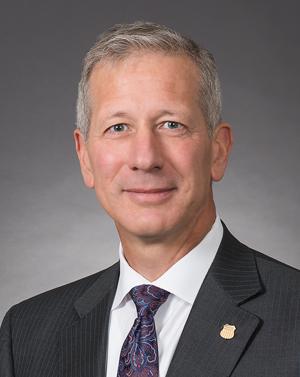“We continue to evaluate exactly how are we going to use it,” CEO Lance Fritz told an investor conference on Wednesday. “We had a game plan when we first designed it and started the build. It still looks like a valuable asset so there’s no reason to think that it’s not. But it’s going to be used differently than the original design.”
He did not elaborate and UP did not immediately respond to a request for additional details.
UP is spending $550 million to develop Brazos Yard near Hearne, Texas, at the strategic junction of seven UP main lines. The yard is scheduled to open by the end of the year and construction was under way eight months prior to the October launch of UP’s new operating plan.
The Unified Plan 2020, based on the late E. Hunter Harrison’s principles of Precision Scheduled Railroading, calls for a reduced emphasis on major terminals as cars are pre-blocked at origin and sent further into the network before being switched.
The goal is to reduce the number of times cars are handled en route, which reduces costs and can improve service reliability. As a result of the reduced need for yard capacity, UP is rationalizing some of is local yards.
UP has consolidated yards in the Salt Lake City area, Fritz noted, and is working to do the same in Kansas City, Mo. Fritz says “obvious” opportunities for yard rationalization exist in Pine Bluff, Ark. — home of a hump yard — and at facilities in the Pacific Northwest.
A hallmark of Harrison’s tenure at Canadian National, Canadian Pacific, and CSX Transportation was idling humps at classification yards and converting them to flat-switching facilities.
Thus far, UP has defied expectations that it would reduce its network of classification yards.
In November, Fritz said UP would need Brazos Yard due to the growth of merchandise traffic on the Gulf Coast, where UP’s classification yards are all at, near, or above their fluid capacity.
In light of the reduced car-handlings under its new operating plan, UP reviewed Brazos to determine whether construction work should be halted.
“The answer is, ‘no,’ because of the growth we see coming on,” Fritz said in November. “We still think we need that yard.”
Fritz noted on Wednesday that new Chief Operating Officer Jim Vena, who worked with Harrison at CN and joined UP in January, brings a fresh set of eyes to Union Pacific.
Vena is challenging certain long-held operational assumptions at UP, Fritz says, and is reviewing the railroad’s terminals as he travels the system.
“Jim and I agree that what we are trying to do is teach our team, which is a team of very capable railroaders, how to railroad a little differently,” Fritz says.
UP may hire more people with PSR experience.
“I wouldn’t be surprised if we find one or two other kind of executive-level individuals who can help us over the long run,” Fritz says.
Fritz spoke at the J.P. Morgan Aviation, Transportation & Industrials Conference.















A solution in search of a problem?
Has anyone in the comment section looked into UP’s route map, especially in Texas, and their chemical carloads? Whose to say the changes Brazos could be related to traffic type(s)/direction of flow?
Since UP originates 45% or more of all US rail chemical traffic, plus a lot of merchandise traffic moving to/from Mexico gets either reclassified, or runs through the region, something would have to be done to take tremendous pressure off of the yards in the Chemical Coast. (Remember, one very vocal, and quite large, customer UP deals with in the Chem. Coast is Dow Chemical.)
The only ‘different’ way a hump yard can be operated is not operate it at all. Either that or route main line trains over the hump so you can get a rise out of them.
Used differently? It’s got a built-in hill… Maybe a toboggan run for when it snows?
Don’t “guess” about classification yards in the Houston area. Think back to 1997, when UP closed a 12-track hump at Strang, and tried to shift 700 cars per day to Englewood.
Englewood has 64 tracks in the bowl. It serves a huge industrial area with extensive local rail freight service. If it was not possible to hump another 700 cars at Englewood, how would it be possible to flat-switch there that level of traffic?
Lance, $550 million for a yard is a lot of money too.
My guess is that Centennial Yard in Fort Worth and probably Englewood yard in Houston, both hump yards, are living on borrowed time once Brazos Yard comes on line. Selling off assets is one of the tenets of PSR and the real estate in Fort Worth and Houston would bring in a lot of money for the shareholders, which we know is all that really matters